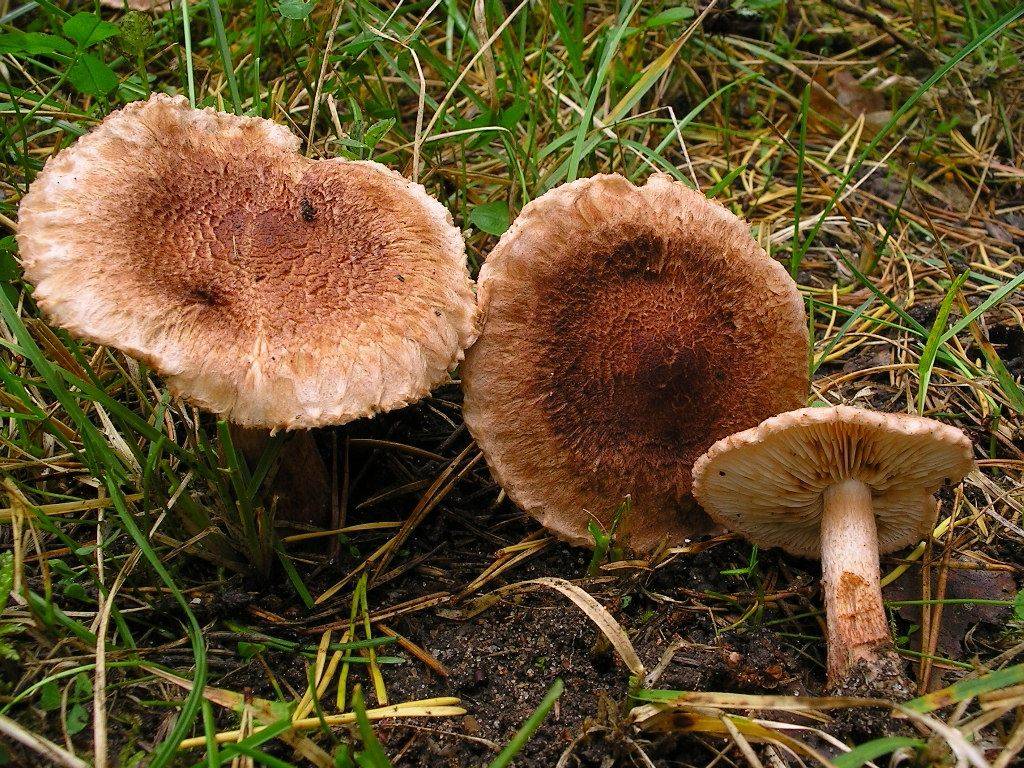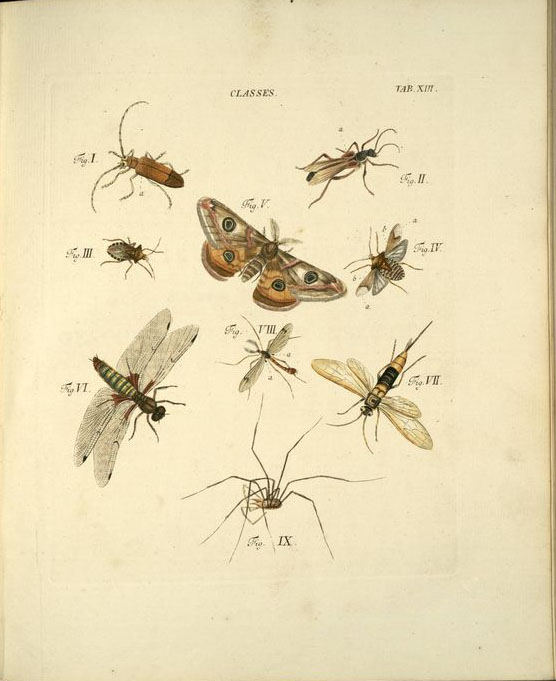|
Tricholoma Vaccinum
''Tricholoma vaccinum'', commonly known as the russet scaly tricholoma, the scaly knight, or the fuzztop, is a fungus of the agaric genus ''Tricholoma''. It produces medium-sized fruit bodies (mushrooms) that have a distinctive hairy reddish-brown cap with a shaggy margin when young. The cap, which can reach a diameter of up to wide, breaks up into flattened scales in maturity. It has cream-buff to pinkish gills with brown spots. Its fibrous, hollow stipe is white above and reddish brown below, and measures long. Although young fruit bodies have a partial veil, it does not leave a ring on the stipe. Widely distributed in the Northern Hemisphere, ''Tricholoma vaccinum'' is found in northern Asia, Europe and North America. The fungus grows in a mycorrhizal association with spruce or pine trees, and its mushrooms are found on the ground growing in groups or clusters in late summer and autumn. Although some consider the mushroom edible, it is of poor quality and not recommended f ... [...More Info...] [...Related Items...] OR: [Wikipedia] [Google] [Baidu] |
Jacob Christian Schäffer
Jacob Christian Schäffer, alternatively Jakob, (31 May 1718 – 5 January 1790) was a German dean, professor, botanist, mycologist, entomologist, ornithologist and inventor. Biography From 1736 to 1738 he studied Theology at the University of Halle before becoming a teacher in Ratisbon. In 1760, the University of Wittenberg gave him the title of Doctor of Philosophy, and the University of Tübingen awarded him in 1763 the title of Doctor of Divinity. In 1741, he became a pastor of a Protestant parish. In 1779, while still a pastor, he also became the dean of the Protestant parish in Ratisbon. Works In 1759, Schäffer published ''Erleichterte Artzney-Kräuterwissenschaft'', a handbook of botany and the medicinal effects of plants for doctors and pharmacists. From 1762 to 1764, he wrote four richly illustrated volumes on mycology, ''Natürlich ausgemahlten Abbildungen baierischer und pfälzischer Schwämme, welche um Regensburg wachsen''. In 1774, he wrote ''Elementa Ornitholo ... [...More Info...] [...Related Items...] OR: [Wikipedia] [Google] [Baidu] |
Edible Mushroom
Edible mushrooms are the fleshy and edible fruit bodies of several species of macrofungi (fungi which bear fruiting structures that are large enough to be seen with the naked eye). They can appear either below ground (hypogeous) or above ground (epigeous) where they may be picked by hand. Edibility may be defined by criteria that include absence of poisonous effects on humans and desirable taste and aroma. Edible mushrooms are consumed for their nutritional and culinary value. Mushrooms, especially dried shiitake, are sources of umami flavor. Edible mushrooms include many fungal species that are either harvested wild or cultivated. Easily cultivated and common wild mushrooms are often available in markets, and those that are more difficult to obtain (such as the prized truffle, matsutake, and morel) may be collected on a smaller scale by private gatherers. Some preparations may render certain poisonous mushrooms fit for consumption. Before assuming that any wild mushroom is ... [...More Info...] [...Related Items...] OR: [Wikipedia] [Google] [Baidu] |
Section (botany)
In botany, a section ( la, sectio) is a taxonomic rank below the genus, but above the species. The subgenus, if present, is higher than the section, and the rank of series, if present, is below the section. Sections may in turn be divided into subsections.Article 4 in Sections are typically used to help organise very large genera, which may have hundreds of species. A botanist wanting to distinguish groups of species may prefer to create a taxon at the rank of section or series to avoid making new combinations, i.e. many new binomial names for the species involved. Examples: * ''Lilium'' sectio ''Martagon'' Rchb. are the Turks' cap lilies * ''Plagiochila aerea'' Taylor is the type species of ''Plagiochila'' sect. ''Bursatae'' See also * Section (biology) References Section Section, Sectioning or Sectioned may refer to: Arts, entertainment and media * Section (music), a complete, but not independent, musical idea * Section (typography), a subdivision, especially ... [...More Info...] [...Related Items...] OR: [Wikipedia] [Google] [Baidu] |
Rolf Singer
Rolf Singer (June 23, 1906 – January 18, 1994) was a Germany, German-born mycologist and one of the most important Taxonomy (biology), taxonomists of gilled mushrooms (agarics) in the 20th century. After receiving his Ph.D. at the University of Vienna in 1931 he worked in Munich. By 1933, however, Singer left Germany for Vienna due to the political deterioration in Germany. There he met his wife, Martha Singer. From Vienna, Singer and his wife went to Barcelona, Spain, where Singer was appointed assistant professor at the Autonomous University of Barcelona. Persecution by the Spanish authorities on behalf of the Germany, German government forced Singer to leave Spain for France in 1934. After a fellowship at the Museum d'Histoire Naturelle in Paris, Singer again moved, this time to Leningrad, where he was Senior Scientific Expert at the Botanical Garden of the Academy of Sciences of the USSR. During his time at the Academy, Singer made many expeditions to Siberia, the Altai Mou ... [...More Info...] [...Related Items...] OR: [Wikipedia] [Google] [Baidu] |
Classification (biology)
In biology, taxonomy () is the science, scientific study of naming, defining (Circumscription (taxonomy), circumscribing) and classifying groups of biological organisms based on shared characteristics. Organisms are grouped into taxon, taxa (singular: taxon) and these groups are given a taxonomic rank; groups of a given rank can be aggregated to form a more inclusive group of higher rank, thus creating a taxonomic hierarchy. The principal ranks in modern use are domain (biology), domain, kingdom (biology), kingdom, phylum (''division'' is sometimes used in botany in place of ''phylum''), class (biology), class, order (biology), order, family (biology), family, genus, and species. The Swedish botanist Carl Linnaeus is regarded as the founder of the current system of taxonomy, as he developed a ranked system known as Linnaean taxonomy for categorizing organisms and binomial nomenclature for naming organisms. With advances in the theory, data and analytical technology of biologica ... [...More Info...] [...Related Items...] OR: [Wikipedia] [Google] [Baidu] |
Form (botany)
In botanical nomenclature, a ''form'' (''forma'', plural ''formae'') is one of the "secondary" taxonomic ranks, below that of variety, which in turn is below that of species; it is an infraspecific taxon. If more than three ranks are listed in describing a taxon, the "classification" is being specified, but only three parts make up the "name" of the taxon: a genus name, a specific epithet, and an infraspecific epithet. The abbreviation "f." or the full "forma" should be put before the infraspecific epithet to indicate the rank. It is not italicised. For example: * '' Acanthocalycium spiniflorum'' f. ''klimpelianum'' or ** ''Acanthocalycium spiniflorum'' forma ''klimpelianum'' (Weidlich & Werderm.) Donald * ''Crataegus aestivalis'' (Walter) Torr. & A.Gray var. ''cerasoides'' Sarg. f. ''luculenta'' Sarg. is a classification of a plant whose name is: ** ''Crataegus aestivalis'' (Walter) Torr. & A.Gray f. ''luculenta'' Sarg. A form usually designates a group with a noticeable mor ... [...More Info...] [...Related Items...] OR: [Wikipedia] [Google] [Baidu] |
Manfred Enderle
''Manfred: A dramatic poem'' is a closet drama written in 1816–1817 by Lord Byron. It contains supernatural elements, in keeping with the popularity of the ghost story in England at the time. It is a typical example of a Gothic fiction. Byron commenced this work in late 1816, a few months after the famous ghost-story sessions with Percy Bysshe Shelley and Mary Shelley that provided the initial impetus for '' Frankenstein; or, The Modern Prometheus ''. The supernatural references are made clear throughout the poem. ''Manfred'' was adapted musically by Robert Schumann in 1852, in a composition entitled '' Manfred: Dramatic Poem with Music in Three Parts'', and in 1885 by Pyotr Ilyich Tchaikovsky in his ''Manfred Symphony''. Friedrich Nietzsche was inspired by the poem's depiction of a super-human being to compose a piano score in 1872 based on it, "Manfred Meditation". Background Byron wrote this "metaphysical drama", as he called it, after his marriage to Annabella Millbank ... [...More Info...] [...Related Items...] OR: [Wikipedia] [Google] [Baidu] |
Variety (botany)
In botanical nomenclature, variety (abbreviated var.; in la, varietas) is a taxonomic rank below that of species and subspecies, but above that of form. As such, it gets a three-part infraspecific name. It is sometimes recommended that the subspecies rank should be used to recognize geographic distinctiveness, whereas the variety rank is appropriate if the taxon is seen throughout the geographic range of the species. Example The pincushion cactus, ''Escobaria vivipara'' (Nutt.) Buxb., is a wide-ranging variable species occurring from Canada to Mexico, and found throughout New Mexico below about . Nine varieties have been described. Where the varieties of the pincushion cactus meet, they intergrade. The variety ''Escobaria vivipara'' var. ''arizonica'' is from Arizona, while ''Escobaria vivipara'' var. ''neo-mexicana'' is from New Mexico. See also '' Capsicum annuum var. glabriusculum'' Definitions The term is defined in different ways by different authors. However, the I ... [...More Info...] [...Related Items...] OR: [Wikipedia] [Google] [Baidu] |
Marcel Bon
Marcel Bon (17 March 1925 – 11 May 2014)http://fmbds.org/wp-content/uploads/2014/06/CAFAM-2014-CR-complet.pdf was one of France's best known field mycologists. He was born in Picardy in 1925 and came to mycology through general botany, and pharmacology. He lived at Saint-Valery-sur-Somme, a quaint little town on the mouth of the river Somme, in Picardy, Northern France, which was a former artists' and writers' retreat, and is now a popular tourist town. In 1987, along with two artists (John Wilkinson, and Denys Ovenden) he produced a comprehensive field guide for mycologists, ''The Mushrooms and Toadstools of Britain and North-western Europe''. His other skills were as a pianist, an artist, and a skier. Bibliography *''The Mushrooms and Toadstools of Britain and North Western Europe'', Bon M., (1987) pub. Hodder and Stoughton. ** (paperback) ** (hardback). *''Les tricholomes de France et d'Europe occidentale'', Bon. M, (1984) pub. Lechevalier (Paris). *''Fungorum Rariorum ... [...More Info...] [...Related Items...] OR: [Wikipedia] [Google] [Baidu] |
Lucien Quélet
Lucien Quélet in 1869 Lucien Quélet (14 July 1832 – 25 August 1899) was a French naturalist and mycologist. Quélet discovered several species of fungi and was the founder of the Société mycologique de France, a society devoted to mycological studies. Quélet, having been born in Montécheroux, Doubs, to a farmer, was soon orphaned, and spent his childhood with and was raised by his aunts. In his youth, he is known to have shown a great interest in mycology and botany in general, but also other subject areas such as ornithology and malacology, the study of mollusks. He was schooled at the Montbéliard college, and later studied medicine in Strasbourg. In 1884, he founded the mycological society known as the Société mycologique de France, of which he became the first president. Several years after this, in 1888, Quélet wrote a book, ''Flore mycologique de la France et des pays limitrophes'' (''Mycological flora of France and neighbouring countries''). Quélet also des ... [...More Info...] [...Related Items...] OR: [Wikipedia] [Google] [Baidu] |
Jean-Baptiste Lamarck
Jean-Baptiste Pierre Antoine de Monet, chevalier de Lamarck (1 August 1744 – 18 December 1829), often known simply as Lamarck (; ), was a French naturalist, biologist, academic, and soldier. He was an early proponent of the idea that biological evolution occurred and proceeded in accordance with Naturalism (philosophy), natural laws. Lamarck fought in the Seven Years' War against Prussia, and was awarded a commission for bravery on the battlefield. Posted to Monaco, Lamarck became interested in natural history and resolved to study medicine.#Packard, Packard (1901), p. 15. He retired from the army after being injured in 1766, and returned to his medical studies. Lamarck developed a particular interest in botany, and later, after he published the three-volume work ''Flore françoise'' (1778), he gained membership of the French Academy of Sciences in 1779. Lamarck became involved in the Jardin des Plantes and was appointed to the Chair of Botany in 1788. When the French Nationa ... [...More Info...] [...Related Items...] OR: [Wikipedia] [Google] [Baidu] |







